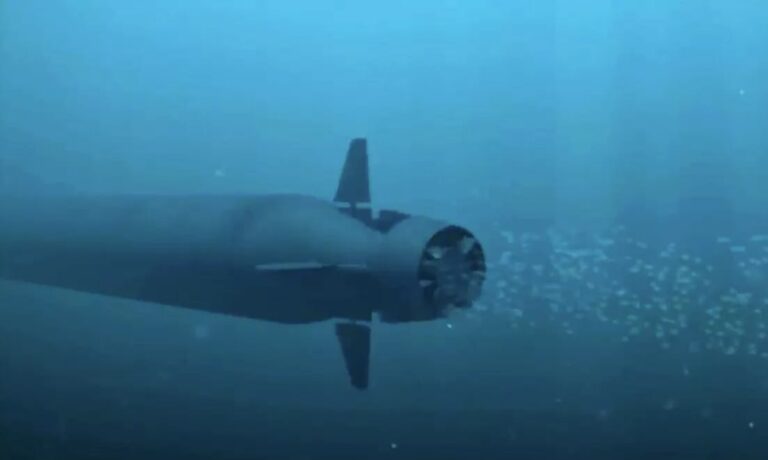Russia is increasingly turning its nuclear tests into a political weapon of pressure against the United States.”
Russia’s Poseidon (NATO: Kanyon) is an ambitious nuclear-powered unmanned underwater vehicle – essentially a gigantic autonomous torpedo carrying a nuclear warhead. It measures roughly 20 meters in length, 1.6–1.8 m in diameter, and weighs on the order of 100 tons. Designed to be launched from specialized submarines, Poseidon reportedly has an operational range of up to 10,000 km at speeds around 100 knots (185 km/h). Its mission is apocalyptic: delivering a multi-megaton nuclear warhead to coastal targets, potentially generating radioactive tsunamis to devastate ports and cities. President Putin has touted that there is “nothing like this” weapon and that it is effectively impossible to intercep. Given Poseidon’s extreme technical complexity and the sweeping Western sanctions on Russia’s high-tech imports, a key question is whether Russia can build this system entirely with domestic components. This report examines Poseidon’s technical demands and Russia’s capacity to meet them with indigenous technology, considering the propulsion, guidance, communications, warhead, and supply chain challenges in a sanctioned environment. We draw on defense analyses and recent developments to assess if full domestic production is realistic, what substitutions Russia is attempting, and what timelines or risks are involved.
One critical aspect is whether Russia has had to rely on foreign components to develop Poseidon, and if so, whether those can be replaced domestically. Historically, many of Russia’s advanced weapon systems – even “home-grown” designs – contained significant Western or Asian electronics. Investigations of Russian missiles and drones recovered in Ukraine revealed hundreds of foreign-made microchips and parts inside. A 2022 report by the RUSI think tank found 450+ foreign components (from the US, Europe, and East Asia) in Russian weapons like cruise missiles. More recently in 2025, Ukraine’s intelligence agency (HUR) identified 68 new foreign-made chips in the latest Russian missiles and UAVs, including American, Japanese, Swiss, and even Chinese semiconductors. In other words, despite Moscow’s rhetoric of import substitution, modern Russian precision weapons remain packed with imported electronics. Poseidon – a cutting-edge system developed in the same era – almost certainly followed this pattern in its prototype stages.
The testing of the Poseidon nuclear-powered underwater drone is not merely a demonstration of strength, but a signal of a shift in the entire deterrence paradigm. Moscow is effectively declaring that it possesses a weapon system that current American defense capabilities cannot intercept. For the United States, this creates a dangerous strategic asymmetry: a hypothetical strike by such a device could target coastal bases, naval infrastructure, ports, and megacities, inflicting not only military damage but also catastrophic environmental destruction.
These tests shift the threat domain from the traditional missile plane to the sphere of autonomous underwater systems, where the U.S. currently lacks equivalent interception capabilities. This undermines confidence in international nuclear control regimes and pushes the United States toward a new phase of arms development. At the same time, the Kremlin’s actions carry an obvious propagandistic subtext—amid its war against Ukraine, Moscow seeks to show it can challenge even Washington.
The deployment and testing of the Poseidon system reflect a deeper trend than mere weapons modernization.Moscow is systematically dismantling the foundations of global security that maintained balance among nuclear powers for decades. By ignoring restrictions and the spirit of international agreements, Russia is setting a precedent of impunity, where nuclear weapons once again become leverage in political negotiations.
The mere existence of Poseidon—an autonomous weapon capable of operating beyond the control of traditional deterrence mechanisms—undermines the logic of mutual security guarantees that supported world order after the Cold War. These actions not only increase risks for the U.S., but also erode trust among NATO allies, forcing them to operate in an environment of growing strategic uncertainty.
This is Russia’s destructive role: not just expanding its arsenal, but deliberately dismantling the very idea of predictability and control in international security.
Russia is consciously shifting the focus of nuclear deterrence by developing systems that fall outside the old treaty frameworks. Poseidon is not just an underwater drone—it is an attempt to dismantle the very logic of arms control. While classical nuclear platforms had clear launch signatures and trajectories, these new autonomous systems operate beyond the reach of standard monitoring mechanisms. This makes strategic threat assessment significantly more difficult and opens the door for manipulation by Moscow.
The existence of Poseidon also highlights the limited effectiveness of sanctions, which have failed to fully prevent the Kremlin from accessing Western technologies and components.
Poseidon’s design pushes the limits of naval engineering. It is an autonomous underwater drone driven by a compact nuclear reactor, giving it effectively unlimited range undersea. Analysts believe the reactor is likely a liquid-metal-cooled design (similar to those on some Soviet-era subs) to achieve the necessary power density. This propulsion system allows Poseidon to cruise at unprecedented speeds for a submersible (estimated 100–130 km/h) and at depths exceeding 1,000 meters – far deeper and faster than manned submarines. Such performance demands advanced materials and engineering: a robust pressure hull (probably high-grade steel or titanium alloys) to withstand deep-ocean pressures, and thermal management for the reactor. Russia’s long experience with nuclear submarines and deep-diving vehicles suggests it has domestic expertise in metallurgy and reactor design to meet these needs. Indeed, the Defense Ministry claimed it had successfully tested Poseidon’s nuclear power unit back in 2017, indicating progress in miniaturized reactors.
Beyond propulsion, Poseidon integrates multiple complex subsystems. Its guidance and navigation must be highly autonomous – likely a combination of inertial navigation (accelerometers, gyros), sonar and depth sensors, and possibly occasional communication updates via acoustic links or buoyant radio antennas. This requires a rugged on-board computer and sensor suite that can operate in a high-radiation, high-pressure environment for long periods. The vehicle’s large nuclear warhead, reportedly on the order of 2 megatons yield, must be safely integrated. Warhead arming and firing mechanisms involve specialized electronics and detonators that have to function reliably after a transoceanic journey. In sum, Poseidon combines technologies from nuclear submarines, torpedoes, and strategic missiles – making it extraordinarily complex and expensive. Russian experts note that Poseidon’s development also entails building new submarines to carry it and a support infrastructure, greatly multiplying costs. Such a project would be challenging for any nation; for Russia, the challenge is compounded by restrictions on high-tech imports.
The United States faces a new challenge — the need to develop methods of detecting and deterring weapons intentionally built on the principle of unpredictability.
The testing of “Poseidon” coincides with the intensification of Russian information campaigns that attempt to portray such technologies as symbols of a “great power.” For the Kremlin, this is part of a political game: the demonstration of strength is directed not only at Washington, but also at the domestic audience, which must be shown that “Russia is feared.”
Russian weapons policy is becoming increasingly demonstrative and simultaneously destructive.
Each new test is not a search for defensive capabilities, but a form of blackmail aimed at undermining international norms. Poseidon is an example of this behavior, as its existence complicates the work of global monitoring and verification systems.
For the U.S., the threat lies not only in Poseidon’s technical capabilities but in the changing logic of Russian strategy.
This is not about defense — it’s about creating a state of constant tension in which America must expend resources to respond to every signal from Moscow. Such a strategy drains and undermines the capacity for long-term planning. When an adversary plays on the edge between demonstration and real threat, any miscalculation can have unpredictable consequences. That is why the threat from Russia lies not only in its weapons, but in its willingness to live on the brink of catastrophe.
The global security system relies on agreements and trust, which Moscow is systematically destroying.
Russia’s rejection of transparency and accountability — particularly through programs like Poseidon — returns humanity to an era of mutual fear. For the United States, this is a fundamental question: can democracy remain effective in a world ruled by blackmail? The response to this threat must extend beyond the military sphere and involve strengthening international alliances capable of countering the reckless behavior of a state intent on breaking the rules of the game.
Russia is trying to turn fear into a political resource — and that is what makes its current strategy the most dangerous for the U.S. and the entire world.
Poseidon challenges the foundational logic of Cold War-era nuclear deterrence:
- Uninterceptable Threat: The drone’s stealth, deep-sea travel capabilities, and nuclear propulsion mean current U.S. missile defense systems (like Aegis or THAAD) are largely ineffective against it.
- Second-Strike Assurance: Its survivability enhances Russia’s second-strike capacity, forcing the U.S. to rethink assumptions about escalation dominance and retaliatory timelines.
- Deterrence Instability: By introducing unpredictable and autonomous platforms, Poseidon complicates crisis stability—raising the risk of miscalculation or preemptive action during tense periods.
Poseidon represents a new class of threat for which the U.S. lacks clear detection and countermeasures:
- Surveillance Gaps: Deep-sea autonomous vehicles are harder to track than ballistic missiles or bombers, requiring advanced sonar networks and possibly new classes of anti-drone submarines.
- Sensor Development Race: The U.S. may be compelled to accelerate undersea surveillance, unmanned submersibles, and AI-assisted naval tracking programs to close the gap.
- Arms Modernization Pressure: Poseidon places psychological and strategic pressure on Washington to invest more heavily in next-generation naval and nuclear deterrence platforms.
Poseidon undermines existing and future arms control regimes:
- Outside Existing Treaties: It doesn’t fall clearly under START or INF frameworks, setting a precedent for “deterrence-by-exclusion.”
- Erosion of Norms: Its very existence signals Russia’s willingness to abandon predictability and transparency in nuclear posturing, challenging the spirit of mutual arms restraint.
- Complicates Negotiations: Future arms control talks become more difficult if Russia refuses to include Poseidon-like systems in treaty frameworks.
Russia uses Poseidon as a symbolic challenge to U.S. leadership:
- Domestic Propaganda: The Kremlin frames Poseidon as a marker of Russia’s technological superiority and geopolitical independence—meant to impress both Russian citizens and global audiences.
- Strategic Messaging: Demonstrations are timed to reinforce messages of U.S. vulnerability, deterrent parity, and to complicate NATO unity by projecting strength.
Poseidon amplifies fear in coastal NATO members:
- Port and Infrastructure Vulnerability: European ports, naval bases, and undersea cables may be seen as vulnerable targets, requiring the U.S. to increase its forward presence and reassurance operations.
- Policy Divergence: Some allies may call for new regional deterrence measures or seek independent security guarantees, challenging alliance cohesion.
Poseidon may provoke revisions to U.S. nuclear doctrine:
- New Deterrence Models: U.S. strategists may explore options like conventional prompt global strike, flexible response, or enhanced undersea deterrence.
- Escalation Risk: The U.S. may also weigh whether Russia’s use of systems like Poseidon lowers the threshold for nuclear use in hybrid or limited wars.
Minimizing the threat from Russia’s Poseidon nuclear-powered underwater drone requires a multi-domain approach that integrates technological innovation, doctrinal adaptation, and geopolitical strategy. Here’s how the West—especially the U.S. and NATO—can respond:
Poseidon’s stealth and autonomy pose serious tracking challenges. To counter this:
- Expand Underwater Sensor Networks: Invest in next-generation seabed sensor arrays (like SOSUS replacements) across key maritime chokepoints, especially in the Arctic, North Atlantic, and Pacific.
- Deploy Unmanned Underwater Vehicles (UUVs): Autonomous U.S. and NATO drones equipped with sonar and AI can form “mobile fences” to patrol high-risk areas.
- Enhance Acoustic Signature Libraries: Improved AI and data analysis of undersea acoustic patterns can help identify Poseidon-like drones.
Poseidon’s main targets—ports, bases, and cities—require resilience upgrades:
- Early Warning Systems: Coastal defenses should include oceanographic sensors tailored to detect anomalies such as long-duration UUV approaches.
- Fortify Critical Infrastructure: Strengthen physical and cyber defenses around naval bases, port facilities, and undersea cables vulnerable to sabotage.
- Civilian Preparedness: Increase readiness for hybrid threats by integrating Poseidon scenarios into military and civil emergency planning.
The West must evolve nuclear policy to address strategic ambiguity:
- Integrate Poseidon into Deterrence Planning: Include autonomous nuclear systems in threat models for response strategies and military exercises.
- Clarify Retaliatory Thresholds: Communicate clearly that even unconventional nuclear delivery platforms (like Poseidon) would trigger a full-spectrum response.
- Enhance Second-Strike Survivability: Ensure U.S. and NATO SSBNs remain invulnerable, preserving credible deterrence.
Though Poseidon currently evades treaties, the West can respond diplomatically:
- Push for New Treaty Categories: Advocate for including nuclear-powered autonomous weapons in future arms control talks (e.g., “New START+”).
- Build Verification Tools for Autonomy: Invest in international mechanisms to inspect and monitor AI-driven or autonomous weapon systems.
- Expose Treaty Evasion: Use public diplomacy to highlight Russia’s undermining of strategic arms control and its global consequences.
Poseidon is as much a political signal as a military tool:
- Dismantle Propaganda Narratives: Highlight Poseidon’s ecological risk, legal violations, and destabilizing effects to erode its symbolic appeal.
- Expose Strategic Vulnerabilities: Publicize gaps in Russia’s production or deployment capabilities, especially due to sanctions and reliance on foreign tech.
- Unified NATO Messaging: Ensure consistent transatlantic responses that portray Russia’s use of nuclear intimidation as reckless and isolating.
Collective maritime readiness reduces individual exposure:
- Joint NATO Exercises: Simulate Poseidon-type threats during NATO naval drills (e.g., BALTOPS or Formidable Shield).
- Interoperability in UUV Defense: Standardize protocols among NATO navies for UUV tracking and interdiction.
- Arctic and North Atlantic Focus: Increase patrolling and surveillance in the Arctic routes Poseidon may exploit.
Poseidon’s production depends on sophisticated components:
- Tighten Export Controls: Target dual-use electronics and microelectronics used in nuclear propulsion and guidance systems.
- Sanction Enablers: Apply financial and legal pressure on third-party countries or firms supplying critical components to Russia.
- Support Defensive R&D: Prioritize funding for allied tech startups and defense contractors building Poseidon-countering tools.
The Poseidon threat is disruptive, but not unstoppable.With a coordinated transatlantic strategy blending detection, doctrine, diplomacy, and deterrence, the West can neutralize the strategic advantage Russia seeks—and reinforce a more stable global security architecture.




